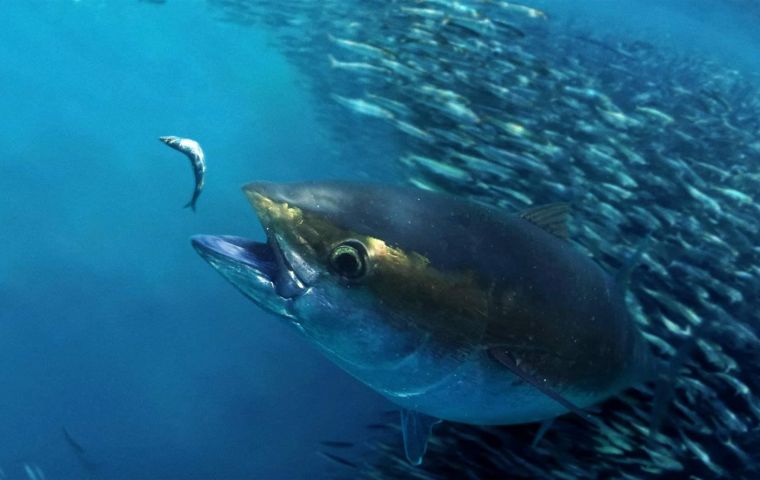MercoPress. South Atlantic News Agency
Survival of the big-eye tuna to be decided this week in ICCAT meeting in Spain
 A scientific report prepared for last year's meeting of the ICCAT showed that numbers had plummeted to less than 20% of historic levels
A scientific report prepared for last year's meeting of the ICCAT showed that numbers had plummeted to less than 20% of historic levels The fate of big-eye tuna, over-fished and in decline, could be decided this week when fishing nations meet to set quotas after failing last year to agree on safeguard measures for the valuable food resource. Scientists warn that unless the catch is reduced, stocks of Thunnus obesus - prized for sashimi in Japan and canned worldwide - could collapse within years.
A scientific report prepared for last year's meeting of the International Commission for the Conservation of Atlantic Tunas (ICCAT) showed that numbers had plummeted to less than 20% of historic levels.
This was only about half what is needed to support a “maximum sustainable yield” - the largest catch that can be taken without compromising the long-term stability of a species.
ICCAT, which groups more than 50 parties including the European Union, convenes in Majorca, Spain, this week for another review of the situation in the Atlantic and the Mediterranean, having failed last year to agree quotas or how to include all members in the system.
Previously, ICCAT has a headline quota of 65,000 tons, but in practice the catch was nearer to 80,000 tons, well into the danger zone, according to NGOs.
The EU on Monday proposed a quota of 62,500 tons through to 2022 which would include 17 countries currently catching more than 1,250 tons a year.
Ivory Coast, Gabon, Ghana and Guinea Bissau, meanwhile, back a quota of 57,500 to 60,000 tons, while the Latin American states of Costa Rica, El Salvador, Guatemala, Honduras, Nicaragua, Panama and Mexico are pressing for no change.
For the Pew Charitable Trusts, “a quota of 60,000 tons would be too high,” fisheries expert Grantly Galland said, suggesting 50,000 tons instead.
A quota of 60,000 tons would make the stock recovery period “too long,” Galland said.
Some experts have calculated that cutting the total catch to 50,000 tons per year would give bigeye tuna a 70% chance of recovery by 2028.
ICCAT will also be looking at other species at risk - albacore tuna and sharks.
For albacore, it suggests a quota of 110,000 tons from 2020.
For its part, the World Wide Fund for Nature recommends that no-go zones be established for certain periods so as to reduce the number of juvenile tuna caught.
As for sharks, which have suffered massive human predation, Senegal is pushing for all shortfin mako sharks caught to be released, dead or alive.
The shortfin mako, also known as the blue pointer or bonito shark, is among the most at risk and is already protected under international trade by the wild fauna and flora CITES convention aimed at controlling trafficking in endangered species.




Top Comments
Disclaimer & comment rulesCommenting for this story is now closed.
If you have a Facebook account, become a fan and comment on our Facebook Page!